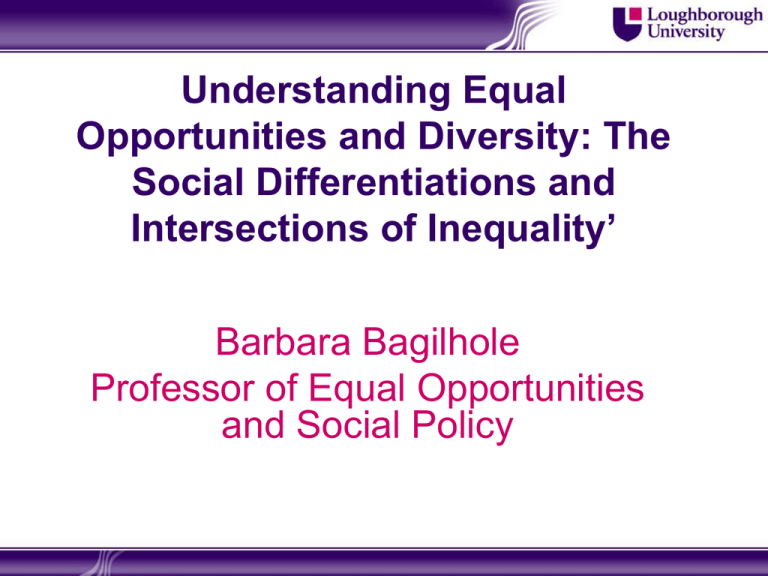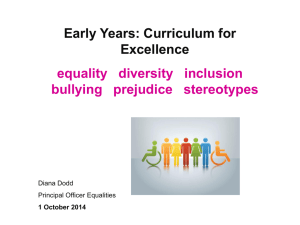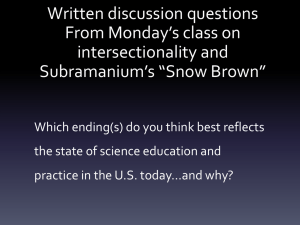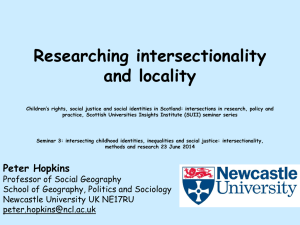
Understanding Equal
Opportunities and Diversity: The
Social Differentiations and
Intersections of Inequality’
Barbara Bagilhole
Professor of Equal Opportunities
and Social Policy
Equal Opportunities & Diversity
Later, more sophisticated coupling of
concepts EO&D
Emphasises:
Recognition of difference
Possibility of ‘multiple disadvantage’
Different treatment legitimate in pursuit of
social equality, fairness & justice
‘Multiple disadvantage’ moved from
rather crude idea of ‘adding up’
disadvantages sophisticated level of
thinking that disadvantages are not
cumulative but interactional – effect
runs more than one way
E.G. Black women – racism infected &
changed by sexism - sexism they
encounter infected & changed by racism
‘NEW KIDS ON THE BLOCK’
‘BIG THREE’ (gender, race &
disability)
‘NEW SIX’ (sexual orientation,
religion or belief & age)
European Union: Perceptions and Attitudes
Perception of discrimination on the basis of
Rare
Widespread
Ethnic origin
30%
Disability
42%
Sexual orientation 41%
Age
48%
Religion or belief
47%
Gender
53%
64%
53%
50%
46%
44%
40%
European Union: Perceptions and Attitudes
Would you say belonging to certain groups
is a disadvantage?
Disadvantage
Being disabled
Aged >50
Ethnic minority
Homosexual
Religious minority
Women
Men
79%
77%
69%
62%
39%
33%
4%
Caution in Millieux of Diversity:
Avoid some inequalities being left
out
Rivalry or competition between
different interests
Recognise stronger interests may
rise above others
Past UK Formula for EO
Ill equipped to fully embrace social dynamics
of race, gender, disability, class, age, sexual
orientation & religion or belief
Legislation – piecemeal, confusing, reactive,
no collective solutions/class actions, complex,
costly, & time consuming
Incremental approach bewildering for
employers & public, & dysfunctional for EO&D
project
Legislation for different target groups not
compatible
Extent and Nature of Heterogeneity of Disadvantage
55m 58m (30 years)
1.6m more over 65 years
5.2m parent couples, 1.6m lone mothers,
180,000 lone fathers
10m disabled people
4.6m ethnic minorities
3.1m non-Christian religion
2.3-3.2m gay, lesbian or bisexual
Fundamental Continuous Disadvantage
Glass Ceiling/Gender Pay Gap – Hourly
17% (38.4% PT)
Caveat – Ethnic origin
Education – girls achieve but discipline
segregation
Sex & Power
Caring Responsibilities
Heterogeneity and Relational Aspect of Disadvantage
Age - mediating factor in gender and
employment
Disability & Employment – lower than nondisabled but also gendered
Ethnic Groups & Employment – EM women
full time – EM men part time – Unemployment
- Heterogeneity of different EM groups
Religious Belief – Muslims lowest
employment – all religious groups
employment activity gendered
Social Justice Agenda
Relatively Recent Major Challenges
Theoretical & Political Challenges:
Post-structuarlist/modernist stances
Critique homogeneity of groups or even
groups as such Deconstruction of groups
Concept of diversity
‘New kids on the block’
Disadvantage dynamic & interactive
E.G. No longer acceptable to act as if women
existed separate from other sources of
disadvantage
Multi-discrimination
‘Double’,
‘Triple’ …
disadvantage?
Potentially list is endless, but
simply counting & adding on
different types of
disadvantage does nothing
to facilitate our
understanding of
simultaneous, interlacing &
interactional disadvantage
Fairytale Analogy
Three minority ethnic women assume the
role of Snow White, rather than the Black
Queen
Each in turn responds to question: ‘Mirror,
mirror on the wall, what is the greatest
oppressor of us all?’
First woman: ‘being black, racism is the main
cause of my oppression’
Second: ‘my life is dominated and controlled by
men. Therefore, sexism is my greatest oppressor’
Third: ‘it is not possible to respond because my
gender, race and class are all causes of my
oppression’
EO&D at Theoretical Impasse?
Poststructuralist/modernist
critiques challenge validity
of ‘truth discourses’ and
‘grand narrative’
Fundamentally
difficult if they only
deconstruct groups,
but do not reconstruct
them in some way
Useful for EO&D
Intersectionality to the Rescue?
Concept and methodology of
‘intersectionality’ Crenshaw (1989)
Acknowledges & stresses importance of intersections of
disadvantage between & within social groups.
‘Intersectionality refers to particular forms of intersecting
oppressions … Intersectional paradigms remind us that
oppression cannot be reduced to one fundamental type, and
that oppressions work together in producing injustice’ Hill
Collins (2000: 180)
Intersectionality to the Rescue?
Focuses on the inter-relationships
between different social divisions –
as either reinforcing or
counteracting each other
Reconstruction of different socially
disadvantaged groups
Need to fine tune policy
•Acknowledges that where
disadvantages interplay &
coincide or conflict between &
within groups new policy
approaches need to be considered
Need to fine tune policy
•Need for analysis that looks at whole people rather
than breaking them up into component parts (e.g,
race separate from gender)
•Individuals possess identities that encompass
multiple, intersecting oppressions that are complex
and shifting
•Intersectionally informed policies can address
issues that may be only relevant for people at a
certain period in their lives, e.g., policies for lesbian
mothers with small children, or for young black men
•Women’s different experiences of exclusion
help us to understand - power relationships
based not only on gender, but also on sexual
orientation, age, disability, race, & religion or
belief
•Sex only one of many inequalities that
construct gender; gender is constructed
through & by distinctions of race, ethnicity,
sexuality, disability, religion or belief, age
INTERSECTIONALITY TO THE POLICY MAKERS RESCUE?
EU policies on diversity and feminist
theories of intersectionality point in
same direction
Democratic process that ‘can on the
one hand look for commonalities
without being arrogantly
universalist, and on the other affirm
difference without being transfixed
by it’. (Yuval-Davis)
‘REALPOLITIK’
Concept of intersectionality illuminates
multiple, intersecting, interlacing nature
of complex social relations both between
& within socially disadvantaged groups
Useful for development of EO&D policy
but complexity must in some way be
contained to allow its utility for reality &
practicality of EO&D policy making
Containing Complexity?
Function in the
context of the
‘Realpolitik’
TAMING COMPLEXITY : 2 METHODOLOGICAL APPROACHES
‘Intercategorical’ – across categories,
quantitative evidence
‘Intracategorical’ – inside category,
qualitative evidence (McCall, 2005)
Recognition of multiple &
intersecting disadvantage
Strategic reconstruction of
recognition of group social
disadvantage that policies can be
based on
‘Intercategorical’ approach
Strategically using existing social
groups, as imperfect & ever changing
as they are
E.G. effect of race on income,
measure how differs for men/women,
for women of higher/ lower class, and
men of higher/lower class? (McCall,
2005)
Comparative approach lends itself to
quantitative methodology
‘Intracategorical’ approach
Intensive, qualitative in-depth case
study of Asian women revealed
complex nature of daily lived
experiences of previously invisible
group (Brah 1992)
Intersectionality accepts
traditional categories albeit
critically & uses them to identify
& study finer points of
intersections
Domestic Violence
A Policy Example
Quantitative
analysis by
race, ethnicity,
class,
disability,
sexual
orientation,
religious
belief, & age
Further
qualitative
analysis of
particular
groups to
analyse
particular
issues
Produce
specialised
positive
action
measures
Northern Ireland Single Commission – A Model to follow?
History of Radical Intervention –
Religious Belief
Proactive Fair Employment Agency
Investigations of organisations (NI Civil
Service)
Compulsory Monitoring
Affirmative Action (short of quotas)
Employment Targets & Timetables
Mainstreaming Equality
Statutory Policy Appraisal – Religion & political
opinion, gender, race & ethnicity, disability, age,
sexual orientation, marital status & those with
dependants
All new policies & service changes assessed
impact on 9 equality groups – adverse impact
ameliorated where possible or justified
Monitoring
Consultation
Complexity of Diversity Mainstreaming
Definition & Scale of Adverse Impact?
Statistical Evidence v Qualitative data
(Sexual Orientation)
Reconciliation of
Conflicting Adverse
Impacts
Conclusion
NI model - a way forward exemplary e.g. of EO&D
mainstreaming with potential for
duplication in other countries?
Most useful if issue of complexity of
diversity, & even problem of
conflicts of interest across & within
disadvantaged groups approached
from an intersectional perspective
Conclusion
Intersectional approaches identified
as ‘intercategorical’ &
‘intracategorical’ - fruitful way
forward for development of EO&D
policy based on research evidence
Intersectionality alerts us to need to
fine tune policy in more
sophisticated manner than in past
‘Injustice anywhere is a threat to justice everywhere’ (Martin Luther King).
Reminds us that all oppressions are interrelated &
mutually constitutive
Debates in UK around:
Multiculturalism versus women’s rights - Genital
Mutilation Act, forced marriages & ‘honour killings’.
Rights of women to abortion, legalised assisted death
& disabled people’s movement
Certain religious beliefs & civil partnerships & gay
adoption
History of EO in UK 60 years – my lifetime
EO&D
Legislation
1940s & 1950s (Two Acts)
DISABLED PERSONS (EMPLOYMENT) ACTS (DPEA) 1944 & 1958
BRITISH NATIONALITY ACT 1948
1960s &1970s (14 Acts)
COMMONWEALTH IMMIGRATION ACT 1962
RACE RELATIONS ACT 1965
LOCAL GOVERNMENT ACT 1966
SEXUAL OFFENCES ACT 1967
RACE RELATIONS ACT 1968
COMMONWEALTH IMMIGRATION ACT 1968
CHRONICALLY SICK AND DISABLED PERSONS ACT 1970
EQUAL PAY ACT 1970
CHRONICALLY SICK AND DISABLED PERSONS ACT 1970
IMMIGRATION ACT 1971
MATRIMONIAL CLAUSES ACT 1973
EMPLOYMENT PROTECTION ACT 1975
SEX DISCRIMINATION ACT 1975
RACE RELATIONS ACT 1976
Equal Opportunities Legislation
1980s & 1990s under Conservative governments (11 Acts)
BRITISH NATIONALITY ACT 1981
EQUAL PAY ACT (amended) 1983
COMPANIES ACT 1985
SEX DISCRIMINATION ACT (amended) 1986
PUBLIC ORDER ACT 1986
LOCAL GOVERNMENT ACT 1988
FAIR EMPLOYMENT PROTECTION ACT, NORTHERN IRELAND
1989
SEXUAL OFFENCES ACT (amended) 1994
DISABILITY DISCRIMINATION ACT 1995
ASYLUM AND IMMIGRATION ACT 1996
EMPLOYMENT RIGHTS ACT 1996
Equal Opportunities Legislation
1990s & 2000s under New Labour governments (27 Acts)
HUMAN RIGHTS ACT 1998
BELFAST AGREEMENT 1998
SCOTLAND ACT 1998
GOVERNMENT OF WALES ACT 1998
CRIME AND DISORDER ACT 1998
IMMIGRATION AND ASYLUM ACT 1999
SEXUAL OFFENCES ACT (amended) 2000
LOCAL GOVERNMENT ACT 2000
RACE RELATIONS AMENDMENT ACT 2000
SEX DISCRIMINATION ACT (amended) 2001
NATIONALITY, IMIGRATION AND ASYLUM ACT 2002
EMPLOYMENT ACT 2002
ADOPTION AND CHILDREN ACT 2002
EMPLOYMENT (SEXUAL ORIENTATION) REGULATIONS 2003
EMPLOYMENT (RELIGION AND BELIEF) REGULATIONS 2003
SEXUAL OFFENCES ACT 2003
CRIMINAL JUSTICE ACT 2003
ASYLUM AND IMMIGRATION ACT 2004
CIVIL PARTNERSHIP ACT 2004
DISABILITY EQUALITY DUTY 2005
EQUALITY ACT 2006
EMPLOYMENT (AGE) REGULATIONS 2006
RACIAL AND RELIGIOUS HATRED ACT 2006
WORK AND FAMILIES ACT 2006
GOVERNMENT OF WALES ACT 2006
GENDER EQUALITY DUTY 2007
EQUALITY ACT 2010
Fantasy
Women % Men %
Judges
94
6
Senior Police Officers
93
7
Skilled Trades
92
8
Newspaper Editors
91
8
MPs
82
18
Professors
81
19
Fantasy Continued
Women % Men %
Nurses
Primary & Nursery teachers
Personal Service Jobs
Secretaries
11
14
16
20
89
86
84
80
Modern Apprentices
Early Years Care
Construction
Plumbing
Engineering
Women % Men %
2
98
99
1
99
1
97
3









